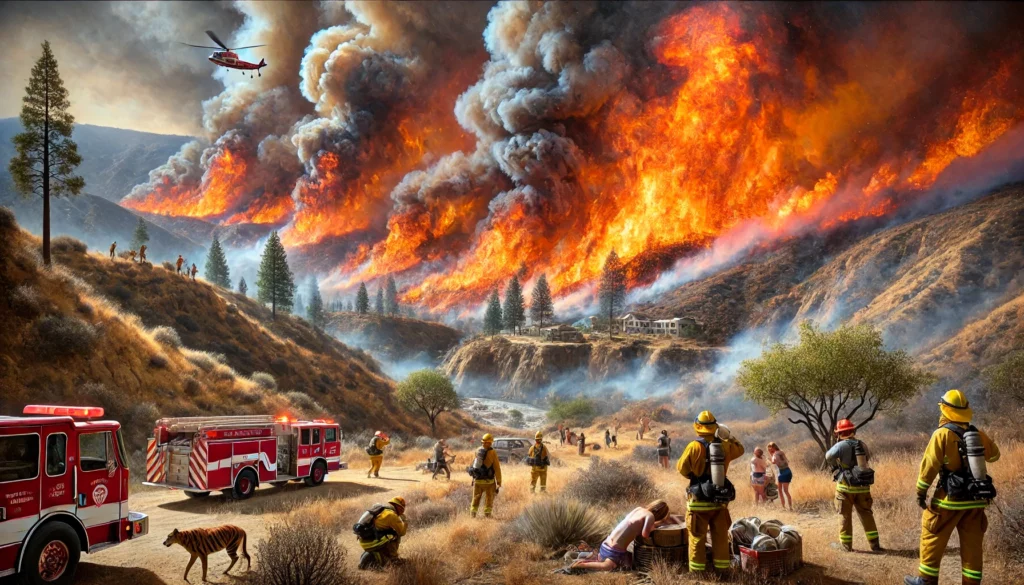The recent wildfires in Los Angeles have drawn global attention, sparking widespread questions like, “How did the LA fire start?” These devastating events, fueled by both human and natural factors, have caused massive destruction, forced evacuations, and left experts searching for solutions to prevent future catastrophes.
In this article, we’ll examine the causes behind the LA fire, its impact, and how it compares to other notable wildfires in recent history.
What Caused the Los Angeles Fire?
The Los Angeles wildfire was the result of a dangerous mix of natural conditions and human activity, creating a perfect storm for disaster. Here are the primary factors:
1. Santa Ana Winds
The Santa Ana Winds, notorious for their dryness and strength, are a key player in Southern California wildfires. These winds can reach speeds of up to 100 mph (160 km/h), drying out vegetation and turning it into highly flammable fuel. Once a fire starts, the winds can rapidly spread the flames across vast areas.
2. Climate Change
The effects of climate change have worsened wildfire conditions in California. Rising temperatures and prolonged droughts have increased the likelihood of wildfires. The state is now experiencing longer fire seasons, with vegetation remaining dry for extended periods.
3. Human Activity
In many cases, human actions—both intentional and accidental—are the root cause of wildfires. For instance, one recent blaze in San Bernardino County was allegedly started by an individual now in custody. Even discarded cigarettes or power line malfunctions can ignite massive fires when conditions are right.
The Impact of the LA Fire
The consequences of the Los Angeles wildfire have been devastating, affecting both people and the environment. Here’s a breakdown of its impact:
1. Human Loss
The fire has claimed at least two lives and left several others injured. First responders have worked tirelessly to rescue individuals trapped in their homes.
2. Mass Evacuations
More than 80,000 residents have been forced to evacuate their homes as flames approached residential areas. Shelters have been overwhelmed, and many families are facing uncertainty about when—or if—they can return home.
3. Environmental Damage
Thousands of acres of forest have been destroyed, including critical wildlife habitats. The smoke from the fire has also contributed to poor air quality in the region, raising health concerns for vulnerable populations.
Comparing the LA Fire to Other Major Wildfires
The Los Angeles fire is not an isolated event; wildfires have become increasingly common worldwide. Let’s compare it to other recent, notable wildfires:
1. California’s Camp Fire (2018)
The Camp Fire was the deadliest and most destructive wildfire in California’s history, killing 85 people and destroying nearly 19,000 buildings. It was sparked by faulty power lines, illustrating the dangers of aging infrastructure combined with dry conditions.
2. Australia’s Black Summer Fires (2019-2020)
Australia’s Black Summer Fires scorched over 46 million acres, killing or displacing an estimated 3 billion animals. Similar to the LA fire, these fires were fueled by extreme heat, drought, and strong winds, further worsened by climate change.
3. Greece’s Evia Wildfire (2021)
In Europe, Greece’s Evia Fire destroyed thousands of acres and forced entire villages to evacuate. Unlike California, Greece’s limited firefighting resources posed significant challenges in containing the blaze.
Why Are Wildfires Becoming More Common?
The rise in wildfires is largely attributed to climate change and urban expansion. Prolonged heatwaves, coupled with human development encroaching on natural areas, have increased the frequency and intensity of wildfires.
Additionally, poor forest management practices, such as the accumulation of dry vegetation, have created tinderbox conditions in many regions.
What Can Be Done to Prevent Future Fires?
To mitigate the risk of wildfires, experts recommend the following measures:
- Improved Forest Management
Controlled burns and vegetation clearing can reduce the amount of dry fuel available to fires. - Stronger Regulations
Enforcing stricter building codes and banning risky activities during fire-prone conditions can prevent accidental ignitions. - Investments in Technology
Advanced satellite monitoring and predictive AI tools can help detect and contain fires early. - Public Awareness
Educating communities about fire safety and evacuation protocols is critical in reducing human-caused incidents.
Final Thoughts
The recent Los Angeles wildfire is a stark reminder of the growing wildfire crisis affecting regions worldwide. While natural forces like winds and drought play a role, human activity and climate change are amplifying the problem.
By understanding the causes and impacts of wildfires—and learning from global examples like the Camp Fire or Australia’s Black Summer—we can take meaningful steps toward preventing future tragedies.

